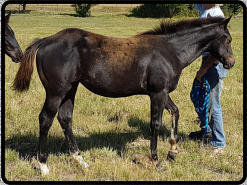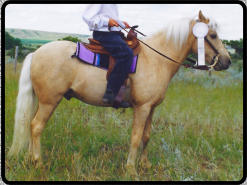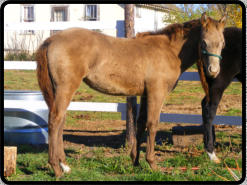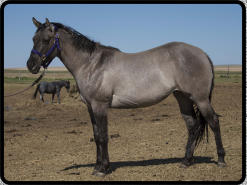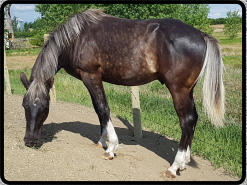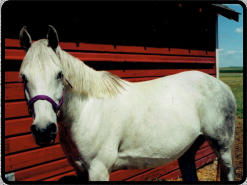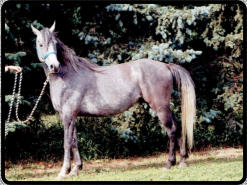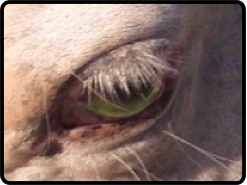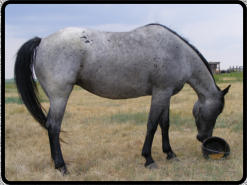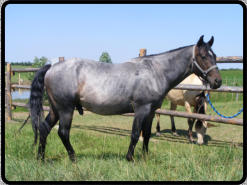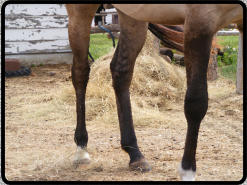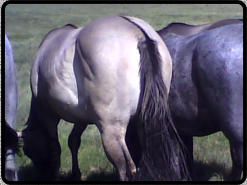
Coat Colour Genetics

Seal Brown & Wild Agouti
Brown (sometimes called Seal Brown), designated as ‘At’, is a mutation of the original Agouti allele. This differs from Agouti in
that, instead of restricting or “erasing” the black colour pigment from the whole of the horse’s body, it only affects the ‘soft’
parts – the nose, armpit, groin, point of the rump, sometimes the belly. The remainder of the body will remain black or very dark
brown. Another mutation of Agouti is known as Wild Agouti (A+) which causes the black points on a Bay horse to extend only above
the pastern instead of up to the knee. When more than one type of Agouti is present, the order of dominance is A (agouti), then
A+ (wild agouti), then At (seal brown).
Over the last couple of years, hot debate has developed with one side claiming that At doesn’t exist and any ‘brown’ horse is
really a Bay. The other side believes that Brown (At) is a seperate colour from Bay. I, along with many others, have found that our
horses with the characteristics described above consistently breed true and therefore we belong to the second camp. At Prairie Silver Quarter Horses we’ve had two
studs that carry the At allele (tested positive before PetDNA Services was closed down) and we have never produced a foal that was Bay after its foal fuzz shed out.
If you are one of those who believe that only Bay exists, you are welcome to do so, I’m not here to change your mind.
Cream
Represented by the letters ‘Cr’, Cream is responsible for horses known as ‘Palomino’ and ‘Buckskin’, among others. Cream is
known as a Dilution, because if one ‘Cr’ is present it only partially changes the original coat colour. Opposite to Agouti, the Cream
gene affects only RED hair on the horse, ‘diluting’ the red hair to a golden hue of varying intensity. In fact, the Cream Gene likes
red in the mane and tail so much that it usually dilutes it all the way to white. Thus, a Sorrel horse with one cream gene becomes
‘Palomino’. Cream does not like Black too much and has a hard time influencing it, therefore a Bay horse will have its red Body
diluted to a golden colour but its black Points will remain black or very dark brown. We know this as a ‘Buckskin’. A Black horse
with the Cream gene is called a ‘Smoky Black’ and may look like a dark Bay, a Liver Chestnut, or barely show the Cream influence
at all.
When TWO Cream genes are present, thing really start to get exciting. With a double Cream (CrCr), the horses’s basic colour is affected much more; so a Sorrel
becomes a Cremello, with pure white hair and blue eyes; a Bay becomes a Perlino, who is usually white with slightly ‘peach’ or ‘off-white’ mane and tail (because
cream has a harder time diluting the black points) with blue eyes; and a Black is now a Smoky Cream horse that will usually have a slightly ‘peach’ or ‘off-white’
colouring overall, also with blue eyes.
Champagne
A rich name for a royal colour, Champagnes are amongst the rarest of colours in the quarter horse world, although more common in
some other breeds. Designated ‘Ch’, the Champagne, like Cream, is also a Dilution which allows the original coat colour to show
through. However, unlike the Cream gene, Champagne is equally happy to influence both red and black hair. A Sorrel horse with the
Champagne gene is known as a Gold Champagne and often looks like a paler coloured palomino with white mane and tail and a
light ‘beige’ or ‘gold’ body. A Bay animal becomes an Amber Champagne, with a taupe or golden brown body and darker, auburn or
ginger mane and tail. And a Black horse will be the highly sought after Classic Champagne with a taupe or gray-brown body.
Sometimes the mane and tail are the same colour as the body, but often they are somewhat darker.
A fascinating aspect of the Champagne gene is that, although the foal’s eyes are pale blue when born, the eyes usually turn green
or hazel as they mature. A sure-fire way to know the horse has a ‘Ch’! Unlike Cream, a double Champagne (ChCh) will not mean
further visual impact on coat colour – but it does, of course, guarantee the following offspring will inherit a Champagne gene (see
Homozygous). Other characteristics of Champagne are pink skin (versus the darker skin of a palomino), which may show through;
and black freckling - usually around the eyes, lips and genitals. Occasionally the gene may create ‘dapples’ on the skin which can
be seen on the body of the horse. It is also important to note that, despite their lighter skin colour, Champagnes are NOT prone to
sunburn or skin cancer, as some have thought in the past.
Dun Factor
The term ‘dun’ can be rather confusing because,
historically, it was often used to refer to a ‘yellow’ or
‘beige’ coloured horse. This is not necessarily related to
genetic Dun Factor (usually shortened to ‘Dun’). Dun Factor,
represented by a ‘D’, is thought to be a very old mutation
and is sometimes referred to as ‘primitive markings’. A
horse carrying the Dun gene will manifest some or all of the
following:
1)
a distinct dorsal stripe running the length of the horse’s back, often down into the tail
(note: it can usually be distinguished from a ‘contour’ line by its sharpness, described as looking like it was ‘painted’ or ‘drawn’ on).
2)
Dilution of the Body to a paler or creamier colour than the original.
3)
A ‘wedge’ or bar of darker hair across the withers (sometime called a ‘Jesus stripe’).
4)
Darkening of the Points and often a darker ‘mask’ over the horse’s face.
5)
Darker ‘Zebra’ striping on the legs (sometimes called ‘tiger’ stripes).
Once again, the original colour of the horse will show through this Dilution, creating a number of rare but beautiful coat colours. A Sorrel with the Dun gene will
become a Red Dun. Usually the most noticeable difference is a brighter red body with a well-defined darker red stripe down the back, although other markings may
also be present. A Bay will now be Classic Dun. Easily mistaken for a Buckskin, the Classic Dun will usually show the distinct dorsal stripe and leg (zebra) barring
unique to the Dun gene. A Black horse is transformed into the rare but lovely Grulla (also spelled Grullo) – with silvery gray to creamy brown body and dark points.
Grulla usually manifest all or almost all of the five attributes listed above, although the body colour itself may vary lighter or darker from horse to horse and even
season to season.
Silver
The first Quarter Horse was identified as having a Silver gene (Z) as recently as 1989, although it is fairly common in some other
breeds. Silver (also known as Silver Dapple or Taffy) only affects Black hair, so a sorrel/chestnut will not manifest this colour (see
Flaxen, below). The silver gene can turn a horse’s mane & tail anywhere from ‘silver’ tipped or streaked – usually seen on Bay
Silvers - all the way to pure white as seen on some Black horses. Black horses with the Silver gene have the most striking colour,
because their bodies will either become dark chocolate or ‘taffy’ coloured or else remain black with silver ‘dappling’ – sometimes
both. There is some debate whether a double Silver (ZZ) will increase the effects of the Silver gene or not, there are too few
examples to make a reasonable determination at this point.
Flaxen
Opposite to Silver, the Flaxen gene only manifests on sorrel/chestnut horses - that is why black-based animals will never have Flaxen manes/tails (see Silver, above).
Another unique aspect of Flaxen is that it only affects the mane and/or tail of a red horse if that animal is carrying TWO RECESSIVE Flaxen genes (ff). The result is a
red-bodied horse with a white or cream-coloured mane & tail. If the horse carries only one Flaxen (Ff) it will be a regularly coloured Sorrel, so BOTH parents must
pass on a recessive ‘f’ to produce this wonderful colour.
Grey
A grey horse, created by the Grey gene (G), is usually born a solid colour, whether Sorrel,
Black or other, and gradually gets more and more white hairs as it gets older. Greys will often
go through a phase when they look similar to Roans; then, as they continue to ‘grey out’ they
become known as ‘grey dappled’ or ‘flea-bitten’ and eventually go completely white. Their
eyes will remain dark, which distinguishes them from other ‘white’ horses such as Cremellos
and Perlinos.
One of the easiest ways to determine if a younger horse is a Roan or Grey is to look at the
head. Roans will usually have a head that is distinctly darker or more solid coloured than their
body, whereas Greys will often have a head that looks lighter than their body because of a greater abundance of white hair. The two pictures to the left are the
same horse at 3 years old (note the head is lighter than the body) and again at 8 yrs old.
Roan
Roan is not actually a colour dilution, but instead is a White Hair Pattern. Roan (Rn) causes a
medium to heavy distribution of white hairs amongst the horse’s original body colour, from the
back of the head down to its knees or slightly higher and all the way to the top of its tail.
Thus, Sorrels become Red (Strawberry) Roans, Bays become ‘Bay Roans’, Blacks become ‘Blue
Roans’, Seal Browns become ‘Seal Brown Roans’, etc.
It is important to understand the difference between a Roan and a Grey horse. Roans do not
continue to get more white hair once they reach maturity and will remain Roan all their lives,
opposed to grey horses which are born a solid colour but get more and more grey hairs over
time until they have turn completely white. Also roaning is usually restricted to the Body and not the Points, whereas Greys will gradually gain white hair
throughout.
There are other White Hair Patterns that can look similar to Roan, such as Rabicano, but these generally do not cover the horse as heavily or uniformly as Roan does.
Tobiano and Overo (Paints & Pintos) are other examples of White Hair Patterns.
